Charlie Hewitt
GASP: Gaussian Avatars with Synthetic Priors
Dec 10, 2024



Abstract:Gaussian Splatting has changed the game for real-time photo-realistic rendering. One of the most popular applications of Gaussian Splatting is to create animatable avatars, known as Gaussian Avatars. Recent works have pushed the boundaries of quality and rendering efficiency but suffer from two main limitations. Either they require expensive multi-camera rigs to produce avatars with free-view rendering, or they can be trained with a single camera but only rendered at high quality from this fixed viewpoint. An ideal model would be trained using a short monocular video or image from available hardware, such as a webcam, and rendered from any view. To this end, we propose GASP: Gaussian Avatars with Synthetic Priors. To overcome the limitations of existing datasets, we exploit the pixel-perfect nature of synthetic data to train a Gaussian Avatar prior. By fitting this prior model to a single photo or video and fine-tuning it, we get a high-quality Gaussian Avatar, which supports 360$^\circ$ rendering. Our prior is only required for fitting, not inference, enabling real-time application. Through our method, we obtain high-quality, animatable Avatars from limited data which can be animated and rendered at 70fps on commercial hardware. See our project page (https://microsoft.github.io/GASP/) for results.
Eyelid Fold Consistency in Facial Modeling
Oct 17, 2024



Abstract:Eyelid shape is integral to identity and likeness in human facial modeling. Human eyelids are diverse in appearance with varied skin fold and epicanthal fold morphology between individuals. Existing parametric face models express eyelid shape variation to an extent, but do not preserve sufficient likeness across a diverse range of individuals. We propose a new definition of eyelid fold consistency and implement geometric processing techniques to model diverse eyelid shapes in a unified topology. Using this method we reprocess data used to train a parametric face model and demonstrate significant improvements in face-related machine learning tasks.
Hairmony: Fairness-aware hairstyle classification
Oct 15, 2024



Abstract:We present a method for prediction of a person's hairstyle from a single image. Despite growing use cases in user digitization and enrollment for virtual experiences, available methods are limited, particularly in the range of hairstyles they can capture. Human hair is extremely diverse and lacks any universally accepted description or categorization, making this a challenging task. Most current methods rely on parametric models of hair at a strand level. These approaches, while very promising, are not yet able to represent short, frizzy, coily hair and gathered hairstyles. We instead choose a classification approach which can represent the diversity of hairstyles required for a truly robust and inclusive system. Previous classification approaches have been restricted by poorly labeled data that lacks diversity, imposing constraints on the usefulness of any resulting enrollment system. We use only synthetic data to train our models. This allows for explicit control of diversity of hairstyle attributes, hair colors, facial appearance, poses, environments and other parameters. It also produces noise-free ground-truth labels. We introduce a novel hairstyle taxonomy developed in collaboration with a diverse group of domain experts which we use to balance our training data, supervise our model, and directly measure fairness. We annotate our synthetic training data and a real evaluation dataset using this taxonomy and release both to enable comparison of future hairstyle prediction approaches. We employ an architecture based on a pre-trained feature extraction network in order to improve generalization of our method to real data and predict taxonomy attributes as an auxiliary task to improve accuracy. Results show our method to be significantly more robust for challenging hairstyles than recent parametric approaches.
Look Ma, no markers: holistic performance capture without the hassle
Oct 15, 2024



Abstract:We tackle the problem of highly-accurate, holistic performance capture for the face, body and hands simultaneously. Motion-capture technologies used in film and game production typically focus only on face, body or hand capture independently, involve complex and expensive hardware and a high degree of manual intervention from skilled operators. While machine-learning-based approaches exist to overcome these problems, they usually only support a single camera, often operate on a single part of the body, do not produce precise world-space results, and rarely generalize outside specific contexts. In this work, we introduce the first technique for marker-free, high-quality reconstruction of the complete human body, including eyes and tongue, without requiring any calibration, manual intervention or custom hardware. Our approach produces stable world-space results from arbitrary camera rigs as well as supporting varied capture environments and clothing. We achieve this through a hybrid approach that leverages machine learning models trained exclusively on synthetic data and powerful parametric models of human shape and motion. We evaluate our method on a number of body, face and hand reconstruction benchmarks and demonstrate state-of-the-art results that generalize on diverse datasets.
GeoGen: Geometry-Aware Generative Modeling via Signed Distance Functions
Jun 07, 2024
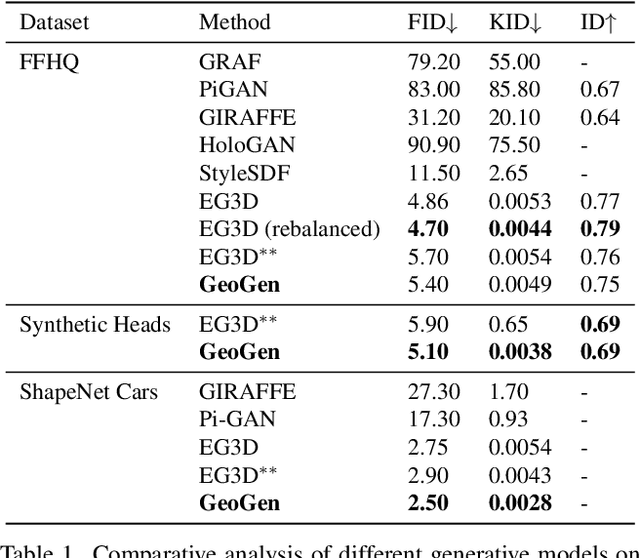
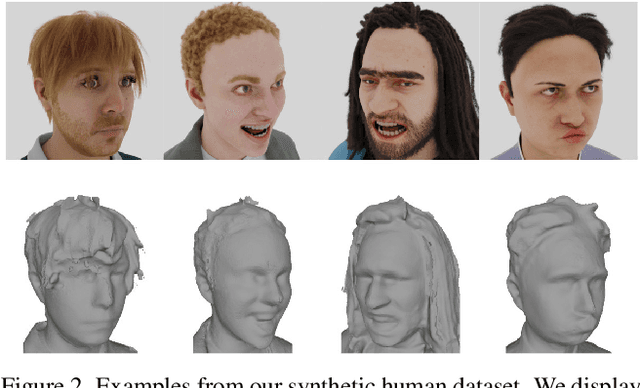
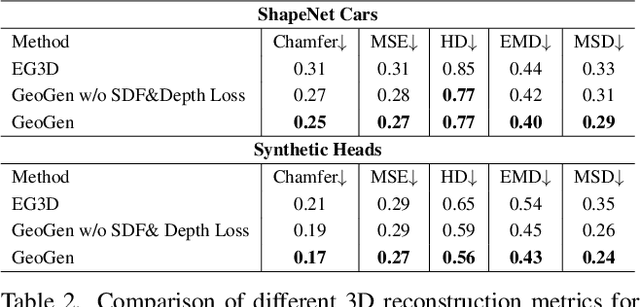
Abstract:We introduce a new generative approach for synthesizing 3D geometry and images from single-view collections. Most existing approaches predict volumetric density to render multi-view consistent images. By employing volumetric rendering using neural radiance fields, they inherit a key limitation: the generated geometry is noisy and unconstrained, limiting the quality and utility of the output meshes. To address this issue, we propose GeoGen, a new SDF-based 3D generative model trained in an end-to-end manner. Initially, we reinterpret the volumetric density as a Signed Distance Function (SDF). This allows us to introduce useful priors to generate valid meshes. However, those priors prevent the generative model from learning details, limiting the applicability of the method to real-world scenarios. To alleviate that problem, we make the transformation learnable and constrain the rendered depth map to be consistent with the zero-level set of the SDF. Through the lens of adversarial training, we encourage the network to produce higher fidelity details on the output meshes. For evaluation, we introduce a synthetic dataset of human avatars captured from 360-degree camera angles, to overcome the challenges presented by real-world datasets, which often lack 3D consistency and do not cover all camera angles. Our experiments on multiple datasets show that GeoGen produces visually and quantitatively better geometry than the previous generative models based on neural radiance fields.
SimpleEgo: Predicting Probabilistic Body Pose from Egocentric Cameras
Jan 26, 2024



Abstract:Our work addresses the problem of egocentric human pose estimation from downwards-facing cameras on head-mounted devices (HMD). This presents a challenging scenario, as parts of the body often fall outside of the image or are occluded. Previous solutions minimize this problem by using fish-eye camera lenses to capture a wider view, but these can present hardware design issues. They also predict 2D heat-maps per joint and lift them to 3D space to deal with self-occlusions, but this requires large network architectures which are impractical to deploy on resource-constrained HMDs. We predict pose from images captured with conventional rectilinear camera lenses. This resolves hardware design issues, but means body parts are often out of frame. As such, we directly regress probabilistic joint rotations represented as matrix Fisher distributions for a parameterized body model. This allows us to quantify pose uncertainties and explain out-of-frame or occluded joints. This also removes the need to compute 2D heat-maps and allows for simplified DNN architectures which require less compute. Given the lack of egocentric datasets using rectilinear camera lenses, we introduce the SynthEgo dataset, a synthetic dataset with 60K stereo images containing high diversity of pose, shape, clothing and skin tone. Our approach achieves state-of-the-art results for this challenging configuration, reducing mean per-joint position error by 23% overall and 58% for the lower body. Our architecture also has eight times fewer parameters and runs twice as fast as the current state-of-the-art. Experiments show that training on our synthetic dataset leads to good generalization to real world images without fine-tuning.
Procedural Humans for Computer Vision
Jan 03, 2023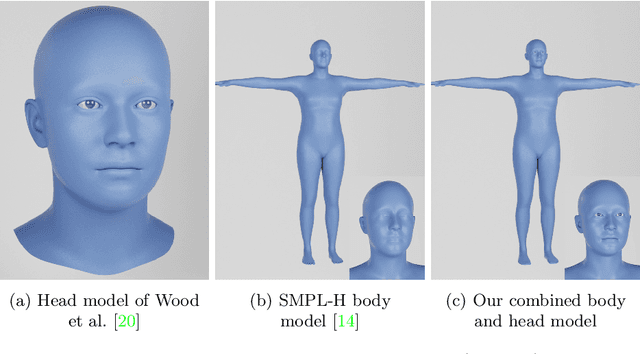
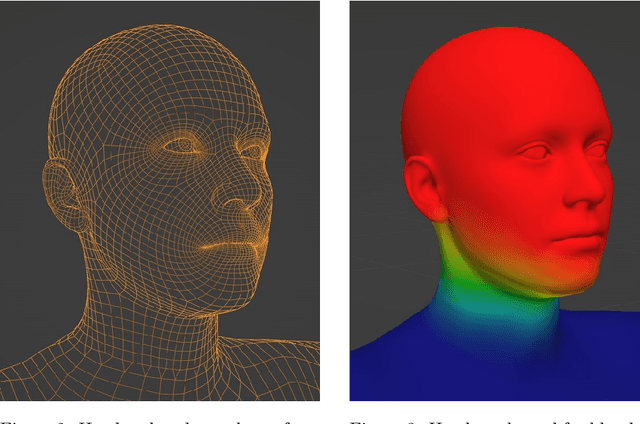
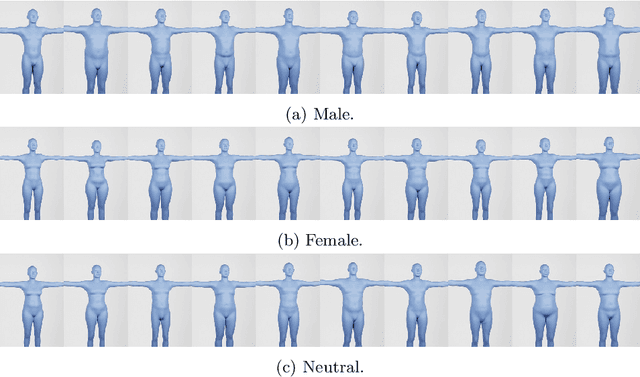
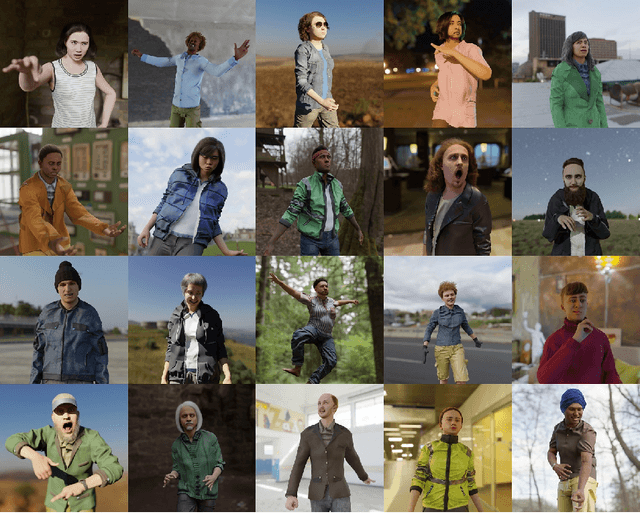
Abstract:Recent work has shown the benefits of synthetic data for use in computer vision, with applications ranging from autonomous driving to face landmark detection and reconstruction. There are a number of benefits of using synthetic data from privacy preservation and bias elimination to quality and feasibility of annotation. Generating human-centered synthetic data is a particular challenge in terms of realism and domain-gap, though recent work has shown that effective machine learning models can be trained using synthetic face data alone. We show that this can be extended to include the full body by building on the pipeline of Wood et al. to generate synthetic images of humans in their entirety, with ground-truth annotations for computer vision applications. In this report we describe how we construct a parametric model of the face and body, including articulated hands; our rendering pipeline to generate realistic images of humans based on this body model; an approach for training DNNs to regress a dense set of landmarks covering the entire body; and a method for fitting our body model to dense landmarks predicted from multiple views.
Mesh-Tension Driven Expression-Based Wrinkles for Synthetic Faces
Oct 05, 2022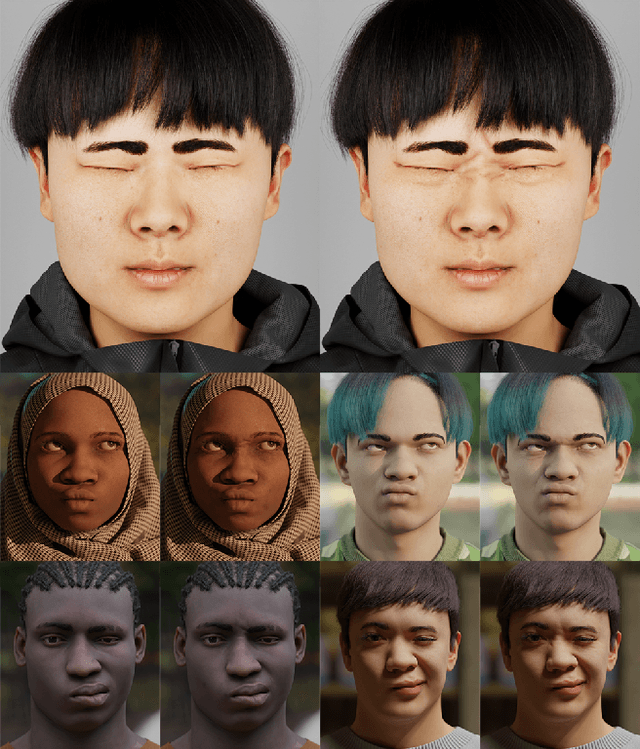
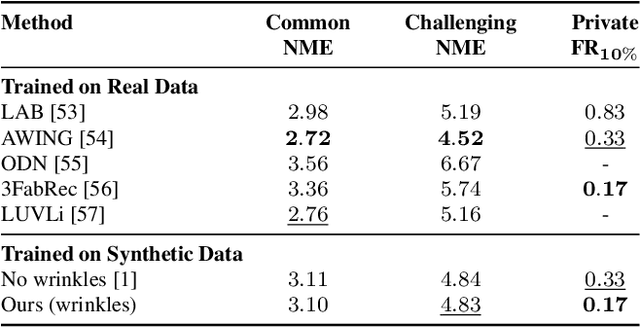

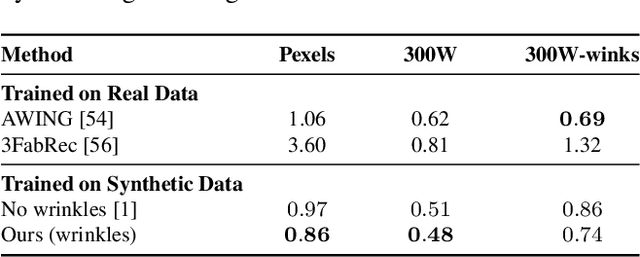
Abstract:Recent advances in synthesizing realistic faces have shown that synthetic training data can replace real data for various face-related computer vision tasks. A question arises: how important is realism? Is the pursuit of photorealism excessive? In this work, we show otherwise. We boost the realism of our synthetic faces by introducing dynamic skin wrinkles in response to facial expressions and observe significant performance improvements in downstream computer vision tasks. Previous approaches for producing such wrinkles either required prohibitive artist effort to scale across identities and expressions or were not capable of reconstructing high-frequency skin details with sufficient fidelity. Our key contribution is an approach that produces realistic wrinkles across a large and diverse population of digital humans. Concretely, we formalize the concept of mesh-tension and use it to aggregate possible wrinkles from high-quality expression scans into albedo and displacement texture maps. At synthesis, we use these maps to produce wrinkles even for expressions not represented in the source scans. Additionally, to provide a more nuanced indicator of model performance under deformations resulting from compressed expressions, we introduce the 300W-winks evaluation subset and the Pexels dataset of closed eyes and winks.
DigiFace-1M: 1 Million Digital Face Images for Face Recognition
Oct 05, 2022

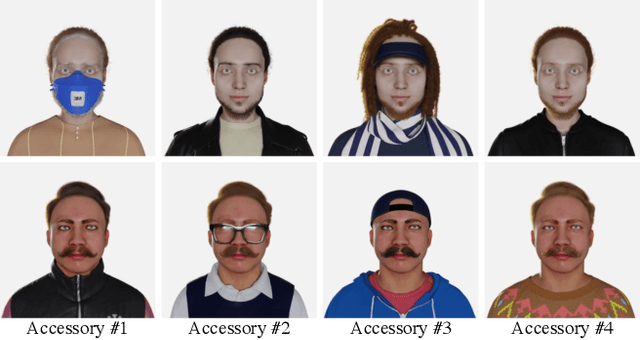

Abstract:State-of-the-art face recognition models show impressive accuracy, achieving over 99.8% on Labeled Faces in the Wild (LFW) dataset. Such models are trained on large-scale datasets that contain millions of real human face images collected from the internet. Web-crawled face images are severely biased (in terms of race, lighting, make-up, etc) and often contain label noise. More importantly, the face images are collected without explicit consent, raising ethical concerns. To avoid such problems, we introduce a large-scale synthetic dataset for face recognition, obtained by rendering digital faces using a computer graphics pipeline. We first demonstrate that aggressive data augmentation can significantly reduce the synthetic-to-real domain gap. Having full control over the rendering pipeline, we also study how each attribute (e.g., variation in facial pose, accessories and textures) affects the accuracy. Compared to SynFace, a recent method trained on GAN-generated synthetic faces, we reduce the error rate on LFW by 52.5% (accuracy from 91.93% to 96.17%). By fine-tuning the network on a smaller number of real face images that could reasonably be obtained with consent, we achieve accuracy that is comparable to the methods trained on millions of real face images.
3D face reconstruction with dense landmarks
Apr 06, 2022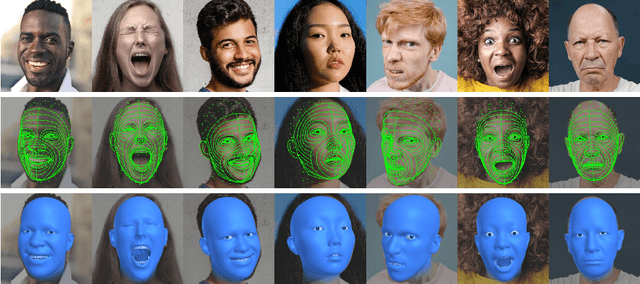



Abstract:Landmarks often play a key role in face analysis, but many aspects of identity or expression cannot be represented by sparse landmarks alone. Thus, in order to reconstruct faces more accurately, landmarks are often combined with additional signals like depth images or techniques like differentiable rendering. Can we keep things simple by just using more landmarks? In answer, we present the first method that accurately predicts 10x as many landmarks as usual, covering the whole head, including the eyes and teeth. This is accomplished using synthetic training data, which guarantees perfect landmark annotations. By fitting a morphable model to these dense landmarks, we achieve state-of-the-art results for monocular 3D face reconstruction in the wild. We show that dense landmarks are an ideal signal for integrating face shape information across frames by demonstrating accurate and expressive facial performance capture in both monocular and multi-view scenarios. This approach is also highly efficient: we can predict dense landmarks and fit our 3D face model at over 150FPS on a single CPU thread.
 Add to Chrome
Add to Chrome Add to Firefox
Add to Firefox Add to Edge
Add to Edge